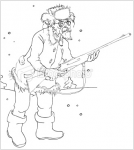Just thought this was worth sharing
In the event of a beacon being activated a 406MHz distress signal is
relayed almost immediately to the Rescue Co-ordination Centre (RCC)
in Wellington, via a high orbit geostationary SAR satellite. In the following
period of time (the length of which depends on where satellites are in the
sky at the time) low orbit satellites then indicate which part of the globe
the signal has come from. For those users who spent the extra money to
buy a GPS enabled PLB, their location will be narrowed even further by
the transmission of their co-ordinates with the distress signal. Standard
procedure at this point is for the RCC to deploy a helicopter that can get
to the vicinity of the distress signal quickly and then zero in on its exact
location, using on board equipment that can home on the local 121.5MHz
signal that PLBs also transmit.
But what happens if the helicopter can’t get there? Flying in the New
Zealand mountains is governed by VFR (Visual Flight Rules) which
basically say that pilots must be able to see the ground, any obstructions
and other aircraft when flying. Helicopters are not permitted to fly into
clouds—particularly when in proximity to the ground. With our mountain
weather being what it is, we have had, and can expect to continue to
have, instances where helicopters cannot get close to an activated PLB
(or ELT—the aviation equivalent).
For a non-GPS enabled PLB, satellites will only be able to indicate
a location with a 5 kilometre degree of accuracy—in a large tract of
backcountry this may only limit the possible location to an area of
approximately 8,000 hectares! Even for GPS encoded signals, normal
120 metre accuracy will leave a search area of up to 5 hectares (or more if
steep terrain or other obstructions reduce the quality of the GPS fix).
Welcome guest, is this your first visit? Create Account now to join.
Welcome to the NZ Hunting and Shooting Forums.
Search Forums
User Tag List
+ Reply to Thread
Results 1 to 7 of 7
Thread: A bit about PLBs
-
17-12-2013, 04:22 PM #1
A bit about PLBs
Forgotmaboltagain+1
-
-
17-12-2013, 04:32 PM #2
Thanks for that Pengy.
I'm hoping Santa has got me one cloud or no cloud it's better than nothing.
Cheers
Pete
-
17-12-2013, 05:04 PM #3
Sorry, I thought I had copied the whole article but seems not.
Anyway...in the event that a chopper cannot get in close enough, steps are being taken to make sure that local SAR groups have the equipment in place to track the signal from the ground. Obviously this means a longer wait for the lost or injured party, but still a whole lot better than no help at all.Forgotmaboltagain+1
-
17-12-2013, 05:08 PM #4
Yip I have one on my wish list but I think I have been a bit naughty this year and Santa is going to punish me for it!!
Oh will Maybe my Birthday??
-
17-12-2013, 05:27 PM #5OPCz


- Join Date
- Jun 2012
- Location
- Nor West of Auckland on the true right of the Kaipara River
- Posts
- 34,659
It takes 43 muscle's to frown and 17 to smile, but only 3 for proper trigger pull.
What more do we need? If we are above ground and breathing the rest is up to us!
Rule 1: Treat every firearm as loaded
Rule 2: Always point firearms in a safe direction
Rule 3: Load a firearm only when ready to fire
Rule 4: Identify your target beyond all doubt
Rule 5: Check your firing zone
Rule 6: Store firearms and ammunition safely
Rule 7: Avoid alcohol and drugs when handling firearms
-
17-12-2013, 05:29 PM #6
Sounds like Mrs TSK has a kinky Santa outfit on the way
 Forgotmaboltagain+1
Forgotmaboltagain+1
-
17-12-2013, 05:33 PM #7
Similar Threads
-
Group purchase deal for PLBs.....
By Mike H in forum Gear and EquipmentReplies: 4Last Post: 14-10-2012, 05:11 PM
Tags for this Thread
Welcome to NZ Hunting and Shooting Forums! We see you're new here, or arn't logged in. Create an account, and Login for full access including our FREE BUY and SELL section Register NOW!!





 3Likes
3Likes LinkBack URL
LinkBack URL About LinkBacks
About LinkBacks



 Reply With Quote
Reply With Quote



Bookmarks